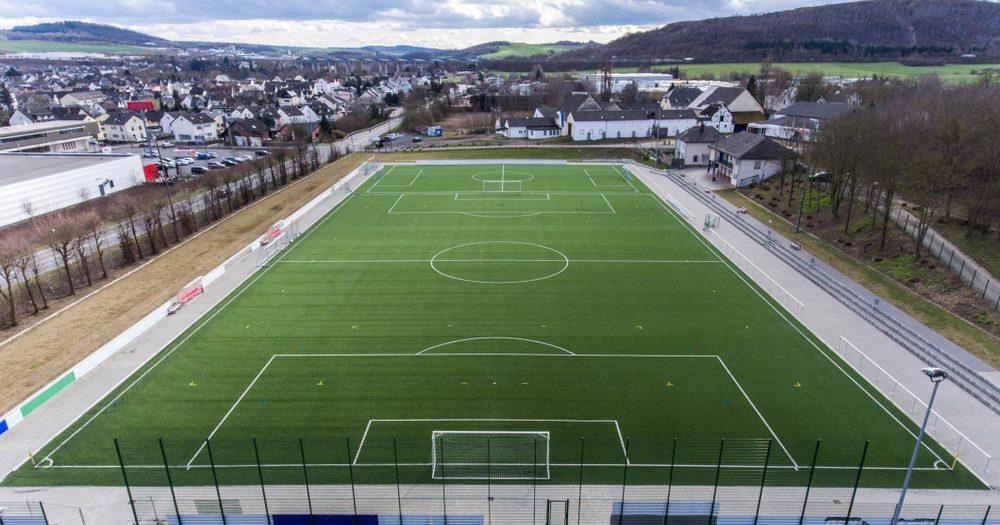If you’re enrolling your kid in a soccer league for the first time, you may find that their games look a lot different from the ones you catch on TV. That’s because, for a game as technical and physically demanding as soccer, it’s best for young players to start off slow to avoid burnout and maintain interest. Kids under the age of 6 typically begin playing on U6 fields, which are usually 75-105 feet in length and 45-75 feet in width. As children get older and grow in athletic ability, they move to larger pitches until they graduate to professional-sized fields, which range from 330-360 feet in length and 210-240 feet in width.
Becoming a stellar soccer player is a journey that involves building confidence, refining physical skill sets, and conditioning endurance – a journey made possible by a gradual growth in field size. Let’s get into why the dimensions of a soccer field matter, and how they can help your young player become the best athlete they can be.
Bạn đang xem: Understanding Soccer Field Dimensions in Youth Games
Youth Soccer Field Dimensions
To ensure that all players have a fair chance of participating and performing well in games, youth soccer leagues usually group kids into age divisions. Namely, U6, U8, U10, and U12 teams (“U6” meaning “under 6 years old”, “U8” meaning “under 8 years old,” and so on). Each age group plays on fields that are specifically sized to support their intellectual and physical development. For example, U6 fields are the smallest in size, making them the best fit for younger kids who need constant engagement and limited athletic demand. Compared to larger pitches, U6 fields facilitate faster games, more touches, and close-knit teams – all ideal conditions to introduce young players to the world of soccer. Here’s a closer look at the dimensions and benefits of each youth soccer field size.
U6 Soccer Field Dimensions
The more compact nature of U6 fields encourages young players to be more aware of their surroundings to better understand the technicalities of the game. The standard dimensions of a U6 soccer field are:
- Field size: 75-105 feet long, 45-75 feet wide
- Goal area: None
- Penalty area: None
U6 leagues are all about the basics and giving everyone adequate time on the field. Kids at this age level learn how to dribble, shoot, and pass the ball, along with the importance of sportsmanship and teamwork. For this reason, teams are often divided into 3v3 and 4v4 games, which enable each player to have more touches on the ball for constant participation. Many leagues also provide each player with a ball during games and avoid using goalkeepers to maximize individual skill development.
Xem thêm : The Impact of Season-Long Participation on ACL Volume in Female Soccer Players
Note that there are no goal or penalty areas on a standard U6 pitch because goalies aren’t used. Instead, a point is scored when the ball crosses a goal line. Additionally, U6 fields are typically set up inside of the area of a larger field using disk markers or shallow cones.
U8 Soccer Field Dimensions
Field dimensions for U8 soccer pitches are usually the same as those of U6 fields, except games are elevated to a 6v6 format. With more players on the pitch, kids can actively learn more about collaboration and coordination while further improving their own skills. U8 soccer fields have the following dimensions, which are the same as a U6 field:
- Field size: 75-105 feet long, 45-75 feet wide
- Goal area: None
- Penalty area: None
U10 Soccer Field Dimensions
Kids older than eight years old move up to U10 soccer fields, which are significantly larger and more reflective of how regulation games are played. Children at this age start to transition into full-length soccer games and are trained to focus more on teamwork drills. On U10 pitches, teams are divided into a 7v7 format with goalkeepers on each end of the field. Here’s what U10 soccer pitches look like in terms of dimensions:
- Field size: 165-195 feet long, 105-135 feet wide
- Goal area: 24 feet wide, 12 feet deep
- Penalty area: 72 feet wide, 36 feet deep
U12 Soccer Field Dimensions
Young players on U12 pitches are ready to showcase everything they’ve learned, from acute tactical awareness to effective (and stylish) dribbling techniques. Soccer games are expanded to a 9v9 format to more closely resemble professional-level matches and help build players’ confidence. Average U12 pitch sizes typically fall within these ranges:
- Field size: 210-240 feet long, 135-165 feet wide
- Goal area: 48 feet wide, 15 feet deep
- Penalty area: 108 feet wide, 42 feet deep
Soccer Field Sizes for Different Games
It wouldn’t make sense for a 3v3 game full of 5-year-olds to play on a regulation-sized field, nor would it make sense for preteen players to play a full 11v11 match on a U6 soccer field. Soccer field sizes help accommodate certain skill levels, athletic abilities, and knowledge, which is why playing on the right size pitch matters. Larger fields are optimal for older players who need to practice strategic thinking and positional plays. We’ll walk you through how a progression in field size can help your child develop the soccer skills they need to succeed.
3v3 Soccer Field
This type of match format can be played on all youth league soccer fields. If your little one falls within the U6 or U8 group, their 3v3 match will take place on the smallest field size listed above for U6 players. For kids in the U10 division or higher, they’ll be playing their 3v3 game on a pitch about 50 feet shorter than their typical field size. The main goal is to allow as many touches on the ball during a match so that players can quickly master or build on basic skills – and smaller fields promote faster turnovers.
6v6 Soccer Field
Xem thêm : Tiki-Taka Soccer: Barcelona’s Style of Play
While 6v6 game formats don’t require a specific pitch size, many youth leagues resort to using soccer fields that average 135-180 feet in length and 105-135 feet in width. As a result, children 9 years and older more commonly play matches with this team size. In a 6v6 game, there are usually only two defenders and a goalie, resulting in shallow team formations that call for smaller fields.
7v7 Soccer Field
Depending on your local soccer association’s rules, kids as young as 9 years old can start to dip their toes into 7v7 games, which are played on fields that range from 165-195 feet long and 105-135 feet wide. However, 7v7 fields are unique in that they use what’s called a “build-out line,” which extends from one side of the field to the other and is located 42 feet away from each goal. It’s used as a marker for the opposing team, who has to stay behind this line while a defending goalie is in possession of the ball and preparing to resume play.
9v9 Soccer Field
The second largest game format before professional 11v11 matches, 9v9 games are usually reserved for children ages 11 and older. Like 6v6 games, there isn’t a strict requirement for field sizes when it comes to 9v9 formats. Nonetheless, average pitch sizes range from 210-240 feet long and 135-165 feet wide – large enough for teams to start practicing strategic gameplay tactics like building out of the back.
11v11 Soccer Field
The game format used by professional soccer leagues, 11v11 matches must take place on pitches that are 330-360 feet long and 210-240 feet wide, which is larger than an American football field! These long games require lots of endurance, agility, concentration, and awareness – making 11v11 matches best for advanced players. It’s also at this stage that developed teamwork and skills make home-field advantage more evident. For example, teams playing on larger home fields might find the gaps between defenders less forgiving on a smaller pitch. As a result, these field sizes are more closely regulated than fields for younger age groups.
FAQs
Q: What are the dimensions of a U6 soccer field?
A: The standard dimensions of a U6 soccer field are 75-105 feet long and 45-75 feet wide.
Q: How big is a U10 soccer field?
A: A U10 soccer field is typically 165-195 feet long and 105-135 feet wide.
Q: Can 9-year-olds play 7v7 soccer?
A: Depending on the local rules, kids as young as 9 years old can start playing 7v7 soccer.
Conclusion
Understanding the dimensions of soccer fields in youth games is essential for providing a suitable environment for young players to develop their skills and enjoy the game. From smaller fields for the youngest players to larger pitches for older and more advanced athletes, each size serves a purpose in fostering growth and learning. By aligning the field dimensions with the age and skill level of the players, soccer leagues can provide an optimal experience for all participants. So, whether your child is just starting their soccer journey or is already a seasoned player, knowing the field dimensions will help you support their development and enjoyment of the beautiful game.
For more information on soccer statistics, player analysis, and game insights, visit Pesstatsdatabase.
Nguồn: https://www.pesstatsdatabase.com
Danh mục: Sport




